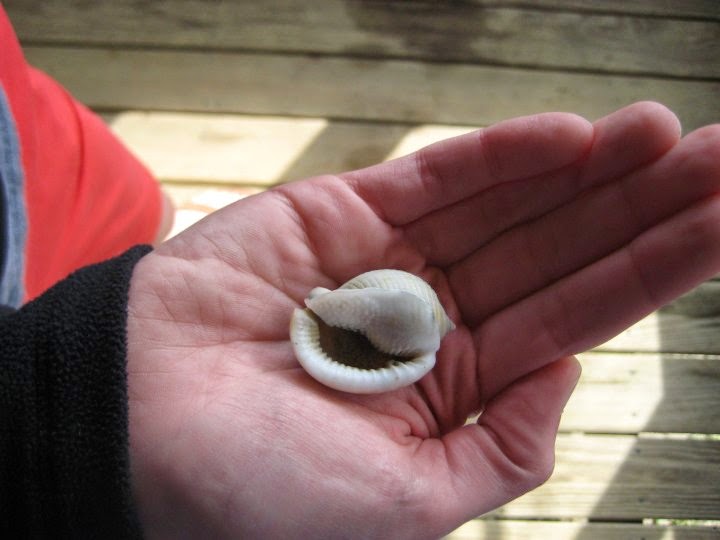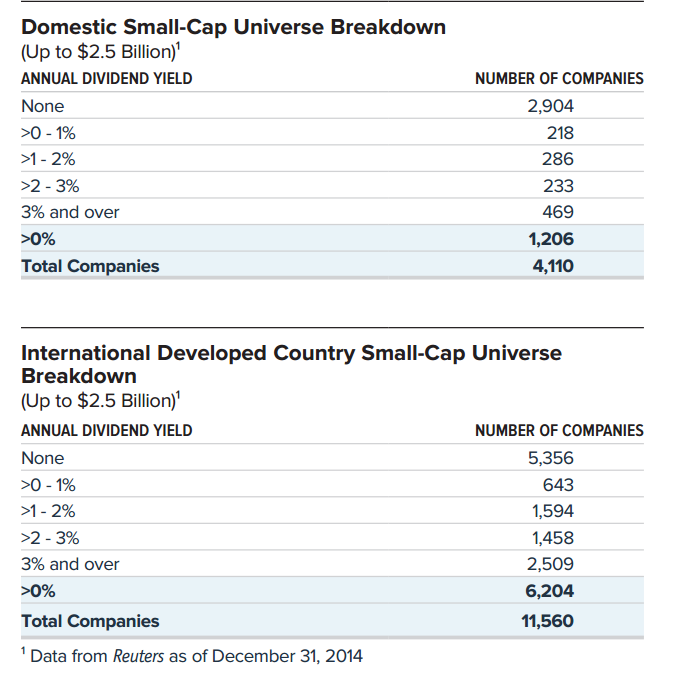Money and Finance
Indeed it did. Within a few minutes on the less-traveled shoreline, we found better shells than we'd found in a few days on the popular beaches, including a relatively hard-to-find intact Scotch bonnet shell.
Where to look
If your aim is to invest in the dividend stocks with best chance of outperforming in the coming years, your energy is best spent in areas of the market with less investor interest.
I'd start with sorting through a list of global smaller-cap dividend payers. As the following table from Royce Funds shows, there are not only a larger number of higher-yielding stocks to consider, but, as smaller companies, these names are less likely to be well-covered and are more likely to be mis-priced. (Of course, they can be mis-priced to the upside as well as the downside, so be sure to do your due diligence before investing.)
When evaluating small cap dividend-paying stocks, I look for the following attributes:
Related posts
- Exploit Your Advantages As An Individual Investor
"Charles Ellis: Turning now to individual investors, do you think that they are at a disadvantage compared with the institutions, because of the latter's huge resources, superior facilities for obtaining information, etc.? Benjamin Graham: On...
- When Companies Aren't Committed To Dividends
Prior to 1982, when large-scale share repurchases became viable after Congress enacted rule 10b-18, nearly all shareholder distributions were returned via cash dividends. As such, companies with longer operating histories tend to have a tradition...
- Where To Find Value In The Dividend Market Today
There's no question that dividend-paying stocks have become more popular in recent years as interest rates on fixed income and savings products declined. Indeed, dividend-focused ETFs and mutual funds have experienced strong inflows, some higher-yielding...
- How To Identify Dividend Prodigal Sons
Dividend Aristocrats...Dividend Achievers...Dividend Champions. We all know what type of companies are on those lists -- companies that have raised their dividends each year without fail for decades. There's certainly a lot to be said for those companies...
- Todd Wenning On Finding Differentiated Dividend Ideas
One of the good things about dividend investing is also a challenge. Dividend investing forces you to screen out many stocks, because they do not pay a dividend at all. And really, for most dividend investors, you are going to want at least a 2 or 3%...
Money and Finance
How to Research Small Cap Dividend-Paying Stocks
The key turning point in my investment management career came when I concluded that because the notion of market efficiency has relevance, I should limit my efforts to relatively inefficient markets where hard work and skill would pay off best. - Howard Marks
A few years ago, my wife and I were vacationing on an island in North Carolina and spent some of our downtime combing the beaches for seashells. We weren't having much luck finding good specimens on the popular main beaches that were picked over by other tourists, so we decided to kayak to a more remote area of the island where the sea met the sound to see if that improved our fortunes.
Indeed it did. Within a few minutes on the less-traveled shoreline, we found better shells than we'd found in a few days on the popular beaches, including a relatively hard-to-find intact Scotch bonnet shell.
 |
| The Scotch bonnet: the state shell of North Carolina |
There are clear parallels for us as investors. So much of the market's attention is focused on the largest companies that finding deeply undervalued companies among them is rare. Like patrolling the popular beaches for good shells, the only times you're likely to find treasure among large cap stocks is right after a storm when everyone is still taking shelter.
Few bargains today
Few bargains today
This was very much the case in the years immediately following the financial crisis when many quality large caps were trading with attractive yields over 3%. Even as late as December 2011, the S&P Dividend Aristocrats Index, which consists of S&P 500 companies that have raised their payouts for at least 25 consecutive years, yielded 2.7%.
Unfortunately, the quality large-cap dividend beach is now as crowded as Panama City on spring break and deep values and attractive yields are thus harder to come by. Of the 53 current S&P Dividend Aristocrats, for instance, only 13 currently trade with dividend yields over 3%.
It's important to keep in mind that the universe of high-quality large cap dividend-paying stocks is relatively small. When we also consider that in the last two years alone, $39 billion flowed to dividend-themed ETFs (most of which are heavily large-cap focused) alone, it's easy to see how valuations have become stretched and yields depressed.
Unfortunately, the quality large-cap dividend beach is now as crowded as Panama City on spring break and deep values and attractive yields are thus harder to come by. Of the 53 current S&P Dividend Aristocrats, for instance, only 13 currently trade with dividend yields over 3%.
It's important to keep in mind that the universe of high-quality large cap dividend-paying stocks is relatively small. When we also consider that in the last two years alone, $39 billion flowed to dividend-themed ETFs (most of which are heavily large-cap focused) alone, it's easy to see how valuations have become stretched and yields depressed.
Where to look
If your aim is to invest in the dividend stocks with best chance of outperforming in the coming years, your energy is best spent in areas of the market with less investor interest.
I'd start with sorting through a list of global smaller-cap dividend payers. As the following table from Royce Funds shows, there are not only a larger number of higher-yielding stocks to consider, but, as smaller companies, these names are less likely to be well-covered and are more likely to be mis-priced. (Of course, they can be mis-priced to the upside as well as the downside, so be sure to do your due diligence before investing.)
 |
| Source: Royce Funds |
- Low debt or preferably no debt. More diversified larger firms can get away with having more financial leverage and can typically get better rates on their borrowings, whereas smaller companies tend to be more cyclical or more reliant on one product line, so a rock-solid balance sheet is a must-have for a smaller company that pays a dividend.
- An invested leadership team. Unless they are founders themselves, executives at large companies are unlikely to own a meaningful percentage of the company. To own 1% of a $50 billion company, for example, would require an ownership stake of $500 million. Small cap executives, on the other hand, can more reasonably own a good stake of the business. With small caps, I like to see insiders own at least 5% of the company as it should motivate them to allocate capital with a long-term ownership perspective since they have skin in the game.
- Steady free cash flow generation. This is always necessary when evaluating dividend-paying stocks as dividends must ultimately be funded by free cash flow in order to be sustainable. It's a particularly good sign when a small company is able to generate free cash flow across the business cycle.
- Dominant in a profitable market niche. Small companies with dominant shares of niche markets are less likely to attract the attention of large competitors. In many cases, the niche is too small to make a difference for the large competitors and if the niche is attractive enough, the larger companies are more likely to simply acquire the dominant player instead of entering the market themselves.
- Operates in a decidedly boring industry. I like to see a small company operating in an industry that's unlikely to attract investor attention -- e.g. industrial parts, safety equipment, and food processing equipment. The longer the business can fly under investors' radars and not be of interest to potential competitors, the better.
- A payout ratio below 50%. Small companies with a long growth runway should be reinvesting at least half their cash back into the business to fuel long-term dividend growth. A firm that is paying out much more than 50% of its earnings is likely in the mature or declining stage of its lifecycle.
- Pricing power. If a company can steadily raise its prices on customers each year without losing a meaningful amount of business, it will go a long way toward supporting the current dividend payout and fueling dividend growth for years to come. If the company can't consistently raise prices, it probably doesn't have a durable competitive advantage and it therefore becomes more difficult for the company to protect margins and raise the dividend at a good pace each year. (If they're price-takers, make sure they are low-cost producers.)
Researching smaller cap dividend-paying stocks requires a bit more legwork than researching large caps where information and analysis is more plentiful, but if you want a chance to beat the market by a meaningful margin over the longer-term, it's the right place for dividend-minded individual investors to spend a good chunk of our research time.
Related posts
- Exploit Your Advantages as an Individual Investor
- Where to Find Differentiated Dividend Ideas
- The Benefits of a Focused Investing Approach
- How memories shape market cycles - A Wealth of Common Sense
- Animating Mr. Market - Michael Mauboussin
- Daejan: 259-Fold Gain over 55 Years - Maynard Paton
- The fear of missing out vs. the fear of holding the bag - Howard Lindzon
- Latest issue of Graham & Doddsville - Columbia Business School
- Akre Capital 1988 shareholder letter - Akre Capital
- Finding the right broker for you (UK) - Monevator
- What Pat Dorsey looks for beyond economic moats - ValueWalk
- An evening with a portfolio manager (30 years ago) - Tom Brakke
- Warren Buffett is a closet technical trader (?!) - Midnight Trader
- Two hedge fund managers walk into a bar - Morgan Housel
- The riddle of Tampa Bay - CIO
Stay patient, stay focused.
Best,
Todd
Subscribe to Clear Eyes Investing by Email
Best,
Todd
Subscribe to Clear Eyes Investing by Email
- Exploit Your Advantages As An Individual Investor
"Charles Ellis: Turning now to individual investors, do you think that they are at a disadvantage compared with the institutions, because of the latter's huge resources, superior facilities for obtaining information, etc.? Benjamin Graham: On...
- When Companies Aren't Committed To Dividends
Prior to 1982, when large-scale share repurchases became viable after Congress enacted rule 10b-18, nearly all shareholder distributions were returned via cash dividends. As such, companies with longer operating histories tend to have a tradition...
- Where To Find Value In The Dividend Market Today
There's no question that dividend-paying stocks have become more popular in recent years as interest rates on fixed income and savings products declined. Indeed, dividend-focused ETFs and mutual funds have experienced strong inflows, some higher-yielding...
- How To Identify Dividend Prodigal Sons
Dividend Aristocrats...Dividend Achievers...Dividend Champions. We all know what type of companies are on those lists -- companies that have raised their dividends each year without fail for decades. There's certainly a lot to be said for those companies...
- Todd Wenning On Finding Differentiated Dividend Ideas
One of the good things about dividend investing is also a challenge. Dividend investing forces you to screen out many stocks, because they do not pay a dividend at all. And really, for most dividend investors, you are going to want at least a 2 or 3%...
